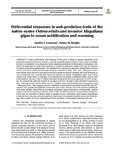Differential responses in anti-predation traits of the native oyster Ostrea edulis and invasive Magallana gigas to ocean acidification and warming
| dc.contributor.author | Lemasson, Anaëlle | |
| dc.contributor.author | Knights, Antony | |
| dc.date.accessioned | 2021-06-08T10:49:25Z | |
| dc.date.issued | 2021-04-29 | |
| dc.identifier.issn | 0171-8630 | |
| dc.identifier.issn | 1616-1599 | |
| dc.identifier.uri | http://hdl.handle.net/10026.1/17235 | |
| dc.description.abstract |
<jats:p>Ocean acidification and warming (OAW) pose a threat to marine organisms, with particular negative effects on molluscs, and can jeopardize the provision of associated ecosystem services. As predation is an important factor shaping populations in the marine environment, the ability of organisms to retain traits valuable in predation resistance under OAW may be decisive for future population maintenance. We examine how exposure to seawater temperature (control: 16.8°C and warm: 20°C) and atmospheric <jats:italic>p</jats:italic>CO<jats:sub>2</jats:sub> (ambient [~400], ~750, and ~1000 ppm) conditions affects traits linked to predation resistance (adductor muscle strength and shell strength) in two ecologically and economically important species of oysters (<jats:italic>Magallana gigas</jats:italic> and <jats:italic>Ostrea edulis</jats:italic>) and relate them to changes in morphometry and fitness (condition index, muscle and shell metrics). We show that <jats:italic>O. edulis</jats:italic> remained unimpacted following exposure to OAW scenarios. In contrast, the adductor muscle of <jats:italic>M. gigas</jats:italic> was 52% stronger under elevated temperature and ~750 ppm <jats:italic>p</jats:italic>CO<jats:sub>2</jats:sub>, and its shell was 44% weaker under combined elevated temperature and ~1000 ppm <jats:italic>p</jats:italic>CO<jats:sub>2.</jats:sub> This suggests greater resistance to mechanical predation toward the mid-21<jats:sup>st</jats:sup> century, but greater susceptibility toward the end of the century. For both species, individuals with more somatic tissue held an ecological advantage against predators; consequently, smaller oysters may be favoured by predators under OAW. By affecting fitness and predation resistance, OAW may be expected to induce shifts in predator-prey interactions and reshape assemblage structure due to species and size selection, which may consequently modify oyster reef functioning. This could in turn have implications for the provision of associated ecosystem services.</jats:p> | |
| dc.format.extent | 87-102 | |
| dc.language | en | |
| dc.language.iso | en | |
| dc.publisher | Inter Research | |
| dc.subject | Predator-prey interactions | |
| dc.subject | Multi-stressors | |
| dc.subject | Climate change | |
| dc.subject | Ecological interactions | |
| dc.subject | Non-native species | |
| dc.title | Differential responses in anti-predation traits of the native oyster Ostrea edulis and invasive Magallana gigas to ocean acidification and warming | |
| dc.type | journal-article | |
| dc.type | Journal Article | |
| plymouth.author-url | https://www.webofscience.com/api/gateway?GWVersion=2&SrcApp=PARTNER_APP&SrcAuth=LinksAMR&KeyUT=WOS:000649299900007&DestLinkType=FullRecord&DestApp=ALL_WOS&UsrCustomerID=11bb513d99f797142bcfeffcc58ea008 | |
| plymouth.volume | 665 | |
| plymouth.publication-status | Published | |
| plymouth.journal | Marine Ecology: Progress Series | |
| dc.identifier.doi | 10.3354/meps13687 | |
| plymouth.organisational-group | /Plymouth | |
| plymouth.organisational-group | /Plymouth/Faculty of Science and Engineering | |
| plymouth.organisational-group | /Plymouth/REF 2021 Researchers by UoA | |
| plymouth.organisational-group | /Plymouth/REF 2021 Researchers by UoA/UoA07 Earth Systems and Environmental Sciences | |
| plymouth.organisational-group | /Plymouth/Users by role | |
| plymouth.organisational-group | /Plymouth/Users by role/Academics | |
| plymouth.organisational-group | /Plymouth/Users by role/Researchers in ResearchFish submission | |
| dcterms.dateAccepted | 2021-03-04 | |
| dc.rights.embargodate | 2022-4-29 | |
| dc.identifier.eissn | 1616-1599 | |
| dc.rights.embargoperiod | Not known | |
| rioxxterms.versionofrecord | 10.3354/meps13687 | |
| rioxxterms.licenseref.uri | http://www.rioxx.net/licenses/all-rights-reserved | |
| rioxxterms.licenseref.startdate | 2021-04-29 | |
| rioxxterms.type | Journal Article/Review |


